 |
Dr. Yasuhiro Morita, Ph.D., Project Manager, Epsilon Launch Vehicle.
Professor, Department of Space Systems and Astronautics, Institute of Space and Astronautical Science / JAXA.
Courtesy of JAXA |
| |
Tokyo, Japan - December 28, 2010
JAXA is developing a new type of solid-fuel rocket, called the
Epsilon Launch Vehicle, aiming for launch in 2013.
Japan’s solid-rocket technology is respected worldwide; the
M-V launch vehicle, which was retired in 2006, had a reputation for the
highest standards of performance.
The Epsilon launch vehicle will reduce costs by incorporating artificial intelligence - a first in rocket history.
A combination of existing and new technologies, this new type of rocket will have a great impact on space transportation.
INTERVIEW
Yasuhiro Morita, Project Manager, Epsilon Launch Vehicle
Rocked Launch Control Via Desktop Computer
Q. Could you tell us about the next-generation solid-fuel rocket, the Epsilon launch vehicle?
The Epsilon launch vehicle is a three-stage solid-fuel rocket. It uses the existing H-IIA solid rocket booster as the first stage, and an upgraded version of the upper stage of the M-V launch vehicle as the second and third stages.
Japan’s solid-rocket history began with horizontal flight tests of pencil rockets in 1955, and all the technologies accumulated over the last half century, from that time until the retirement of the M-V launch vehicle in 2006, are reflected in the Epsilon launch vehicle.
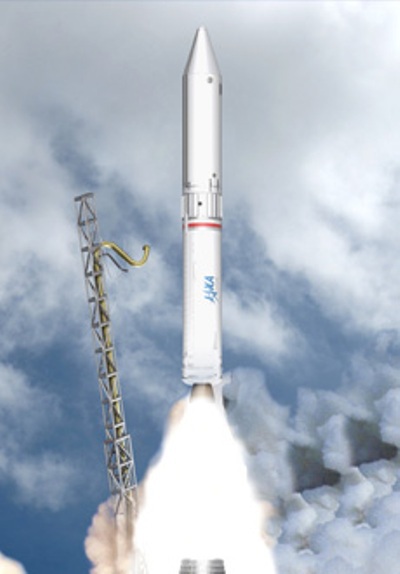 |
Launch of the Epsilon Launch Vehicle (artist’s rendition).
Courtesy of JAXA |
| |
Epsilon is the culmination of decades of advancement in Japanese solid-rocket technology, so I think its reliability and performance will be excellent.
However, Epsilon also uses new, cutting-edge technology.
We aim to greatly simplify the launch system by using artificial intelligence.
Today, a typical scenario is hundreds of people assembling at the launch center and working for several months in preparation for a launch.
On the day of the launch, dozens of people are in the control room, monitoring every aspect.
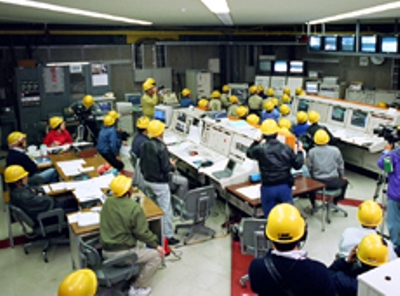 |
Conventional launch control room (JAXA Uchinoura Space Center).
Courtesy of JAXA |
| |
The Epsilon launch vehicle will drastically change this picture.
You may doubt that artificial intelligence can be used in a rocket, but nowadays a self-inspection function is something commonly seen in machinery.
Another example is a medical device such as the electrocardiograph, which uses artificial intelligence to diagnose heart abnormalities.
Ironically, rockets are seen as leading-edge technology, but the approach to their functionality and design is conservative.
Rockets use technology from many generations ago, so they are like a showcase of deficiencies.
There has long been a notion that new technology should be tested over an extended period of time before being used in actual launch vehicles.
Consequently, the latest artificial intelligence applications have not yet been employed in rockets.
The Epsilon launch vehicle will be the first rocket with artificial intelligence that will perform checks and monitor its own operation autonomously.
This is the major difference from the conventional M-V launch vehicle.
Q. What kind of new technologies are currently being developed?
The most significant development in the Epsilon launch vehicle is the capability of running autonomous checks supported by artificial intelligence, which will enable rocket-launch control using a desktop computer (in reality, two computers for redundancy).
We call this "mobile launch control."
The M-V launch vehicle required many devices for ground inspection prior to launch, and hence a lot of time and manpower.
In addition, a number of components had to be manually assembled one-by-one at the launch center.
As a result, from the time the first-stage rocket was positioned on the launch pad to the actual launch, it took about two months.
 |
Artist’s rendition of mobile control.
Courtesy of JAXA |
| |
With the Epsilon launch vehicle, we will be able to greatly reduce the volume of work and manpower because the rocket will perform checks autonomously.
Furthermore, to reduce the number of rocket components, we are simplifying the rocket assembly so we can transfer the launch vehicle to the launch center in an almost fully assembled state.
This will make it possible to launch the rocket only a week after its first stage is placed on the launch pad.
We are also working on reducing the weight of the propellant container, known as the motor case.
The M-V rocket’s motor case was made of light and tough carbon fiber, and as a result it was the world’s lightest rocket in its class.
Now, we are trying to make an even lighter motor case for the Epsilon launch vehicle, and also studying how to optimize the manufacturing process.
In the conventional process of making a carbon fiber motor case, fiber saturated with resin, known as prepreg, is wrapped many times around a mold.
Then, compressed under high pressure, the mold is fired at high heat for solidification.
This is done in an autoclave, which supplies the high pressure, but that’s a large and expensive facility.
For the Epsilon launch vehicle, we have improved the method of glue penetration so that the mold can be solidified without applying pressure.
This has made the manufacturing process cheaper and simpler.
Also, we have switched to a tougher carbon fiber and have been able to make a lighter and stronger motor case as a result. In this way, we obtain the higher performance structure by the lower cost.
Artificial Intelligence Helps Cut Costs
Q. How much cost reduction are you aiming for?
We plan to develop the Epsilon launch vehicle in two stages.
The objective of the first stage is to launch a space telescope for planetary observation - the small scientific satellite SPRINT-A, scheduled for launch in 2013.
The Epsilon launch vehicle will achieve drastic cost reductions with various innovations, including a shorter launch preparation time, mobile launch control, and an improved manufacturing process for the motor case.
As a result, the estimated cost of the first launch in 2013 is about 3.8 billion yen - almost 50% less than the 7.5 billion yen price tag for the M-V launch vehicle.
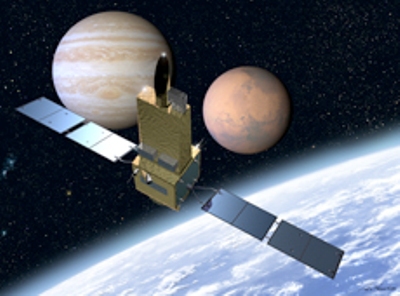 |
First small scientific satellite SPRINT-A.
Courtesy of JAXA |
| |
For low Earth orbit satellite launches, the launch capacity of the Epsilon rocket will be 1200 kilograms - about two thirds of the M-V launch vehicle, which had a capacity of 1800 kilograms.
The cost will be reduced by half but at the expense of some of the launch capacity, so all told the cost performance will be improved by 25 percent.
Unfortunately, I think that cost is still relatively high to carry out more frequent launches.
So the objective of the second stage of our development plan is to launch a rocket for under 3 billion yen by 2017.
After the first launch in 2013, we hope to launch one rocket each year.
This means that the launch in 2017 will probably be the fifth rocket. If we can drive down the cost of the Epsilon launch vehicle even further, monthly rocket launches, for example, will no longer be just a dream.
Q. Will the Epsilon launch vehicle carry only small satellites?
Our plan for now is to launch small satellites, with a total mass of 500 kilograms or less, but the Epsilon launch vehicle is capable of launching a low Earth orbit satellite with a mass of up to 1200 kilograms.
A 1200 kilogram-class satellite is considered mid-sized.
The Epsilon rocket will also be able to launch a small planetary exploration spacecraft of around 300 kilograms.
The asteroid explorer Hayabusa was 500 kilograms, so I think it is possible to devise a lighter, smaller exploration spacecraft.
In fact, some researchers have shown an interest in using the Epsilon launch vehicle to launch spacecraft for lunar and planetary exploration.
Small scientific satellites will be the main target for a while, but the Epsilon is full of potential. Although it’s only 24 meters high, shorter than the 30.8-meter M-V rocket, I believe it has greater potential than the M-V.
Miniaturization Is a Key to Space Development
Q. Does the Epsilon launch vehicle use the same propellant as the one used for the M-V rocket?
Yes, it is the same propellant.
The first Epsilon rocket will take off in 2013, which is coming up soon.
It takes so much time and labor to change the fuel that for the time being we will stick with propellant that’s been proven reliable.
We are planning to develop new solid fuel in the next stage.
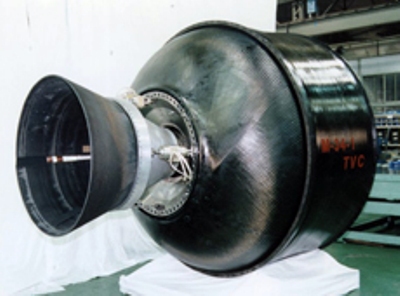 |
M-V rocket motor case.
Courtesy of JAXA |
| |
There is currently a wide variety of research on new fuel.
One that we are studying is something that will fundamentally change the production method of solid-rocket fuel.
Conventionally, solid rocket propellant is blended with a mixer in a half-liquid condition, poured into a motor case, then heated for shaping.
Once it has solidified, it cannot be brought back to a half-liquid state, so there isn’t much time to conduct the entire process.
And therefore, even if the required amount of propellant is prepared and divided into a few portions for mixing, it requires very large mixers.
In addition, when transferring propellant into the motor case, you have to be very careful to ensure that there are absolutely no bubbles.
It is a very intense one-shot deal.
On the other hand, the fuel we are developing is made completely the opposite way.
This fuel will melt as many times as it is heated, and harden again at room temperature - just like a chocolate bar.
That allows a fresh start when it is necessary.
For these characteristics, it has the key benefit that the mixer can be small.
Propellant is blended with a small mixer, produced little by little, nonstop, and can be stored like a chocolate bar.
Then when there is enough, it can be melted and inserted into the launch vehicle so that it fits perfectly.
This is a far more efficient method of fuelling a rocket. I think that one key to the future of space development is miniaturization, which increases efficiency.
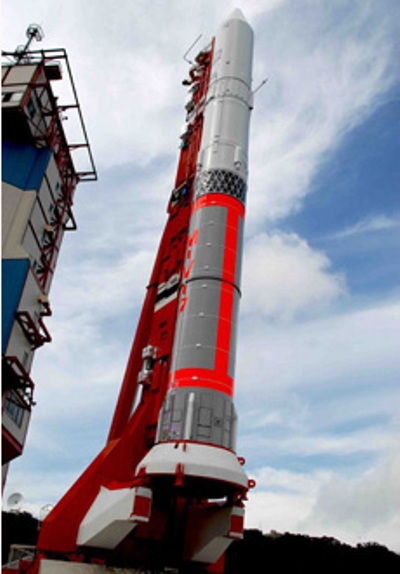 |
M-V launch vehicle.
Courtesy of JAXA |
| |
A small mixer is also beneficial in terms of cost.
A conventional large mixer not only costs billions of yen to make, but the maintenance fees are also immense, and on top of that, it involves many engineers, so personnel costs are high.
With a small mixer, all these costs are reduced, so the cost of a rocket launch is a lot lower. Instead of just complaining over the shortage of funds for space development, I think that we need to come up with innovative ways to work within the limited budget we do have.
Q. But if operations are streamlined too much, the volume of employment will be cut down as well. Won’t space manufacturers be hesitant about miniaturization?
Certainly, some manufactures are reluctant to do so.
However, without making machinery smaller and also reducing manpower, I think it will be difficult for the space industry to survive in the future.
When a factory’s manufacturing process is streamlined, the profit from each unit may be reduced, but it won’t be a loss overall as long as production volume is increased.
I think manufacturers and scientists have similar goals: they need to make a larger number of products to make a profit, and we want to launch many satellites.
Personally, I don’t dislike the current process of launch preparation, where many people gather and camp out at the launch center for a few months.
In fact, that was one of the reasons I enjoyed my job.
However, this style hasn’t changed at all since the Apollo era of the1960s.
For the future of rocketry, in my opinion, we need to build a system where launch vehicles can take off frequently and come back like airplanes.
Unless we change the existing approach and establish a system for rockets to be launched by just a few people, the next generation of rockets will never be born.
Someone needs to pull the trigger at some point, and I believe it’s our job to do so.
Lowering the Barriers to Reaching Space
Q. Solid-fuel rockets are said to be more difficult to guide and control compared to liquid-fuel rockets. What is your opinion on this?
With liquid-fuel rockets, it is possible to stop the engine and still control the thrust after launch.
But with solid-fuel rockets, the engine cannot be stopped in mid-course once it is ignited. This is why solid rockets are said to be difficult to guide and control.
But this does not mean they have poor accuracy in guidance and control.
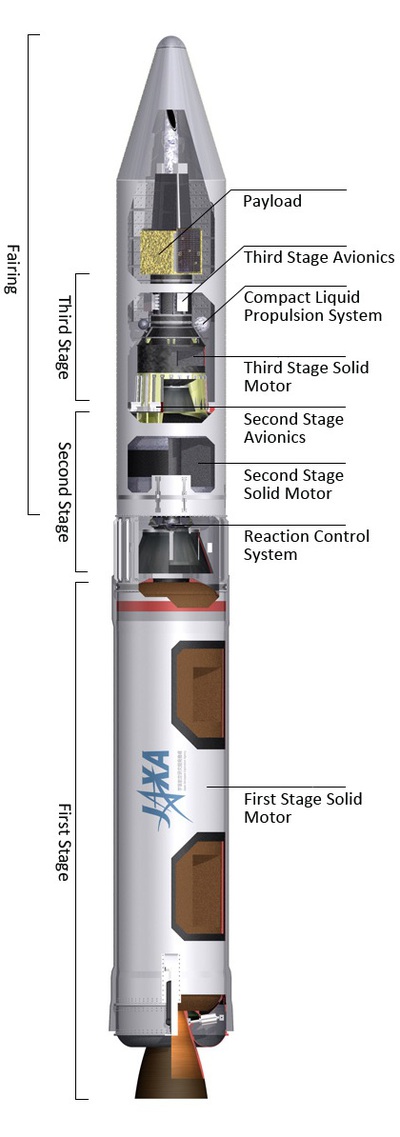 |
Cross-section of the Epsilon launch vehicle.
Courtesy of JAXA |
| |
To control the orbit of a satellite, you have to acquire information on its location and velocity at a given point.
The location is determined based on the three spatial dimensions - for example, latitude, longitude and altitude.
The three-dimensional information also includes the speed at each dimension, so the velocity is also three-dimensional information.
With these six coordinates - three for location and three for velocity, we can determine the orbit of a satellite.
The engine burn of a solid-fuel rocket cannot be stopped, which means it is impossible to adjust for all six coordinates to meet the needs of a satellite.
So the question is, what can we do?
Each satellite or planetary exploration spacecraft has its own specific coordinates that take precedence, so we just focus on those.
For example, the solar physics satellite Hinode was launched into Sun-synchronous orbit to travel in a north-south direction above the Earth.
What was important in that case was the relationship between the angle of inclination of the orbital plane to the equatorial plane, and the height of the apogee - the height where the satellite is farthest from Earth.
As long as we can ensure that the correlation of these two parameters corresponds, a satellite can be launched into its desired orbit.
However, to achieve this, the satellite developer has to have a good understanding of the performance of the rocket, and the rocket developer has to have a good understanding of the performance of the satellite.
At the Institute of Space and Astronautical Science/JAXA, rocket developers and satellite developers work in the same building, so we can solve problems by dropping in on each other and asking for advice.
But we also would like university professors who don’t know very much about rockets to become users of the Epsilon launch vehicle.
So our plan is to install a small liquid-fuel engine, which was used to control the attitude of the M-V launch vehicle, on Epsilon’s third stage.
This will enable orbit insertion with similar accuracy to a liquid-fuel rocket. If access to space becomes easier, there will be more rocket users.
With the Epsilon launch vehicle, we would like to greatly lower the barriers for reaching space.
Q. What do you pay special attention to in improving the reliability of launch vehicles?
The Epsilon launch vehicle uses upgraded versions of technology used in the M-V and H-IIA rockets.
So because these are tried-and-true components, the development of the Epsilon began with guaranteed reliability.
And with the addition of artificial intelligence, I believe that the rocket’s reliability will keep growing.
Applying artificial intelligence is not just about installing a sophisticated electronic brain; we will also implant our know-how.
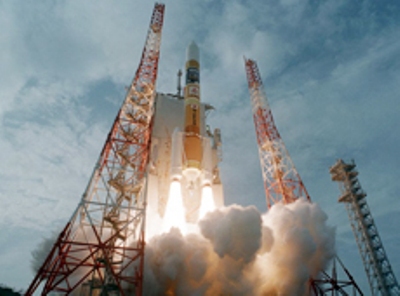 |
H-IIA launch vehicle.
Courtesy of JAXA |
| |
For example, in rockets orbit is controlled with a nozzle that expels combustion gas: orbit deviation is corrected by changing the direction of the nozzle.
The nozzle is controlled with electricity, and by looking at the corrugated pattern of the electric current, we can tell if it’s moving correctly.
The corrugated pattern is equivalent to an electrocardiogram of our bodies, and it is very much like checking the heart of a rocket.
Everything we know about how to use this pattern to judge normality or abnormality will be implanted in the rocket.
More precisely, we will create a thorough list of how malfunctions of each component would impact the rocket overall, and implant that information into its artificial-intelligence "brain." Through this process we can also clarify which parts have to be built particularly tough and it will enhance the rocket’s reliability.
Acquisition of the World’s Most Advanced Rocked Technology
Q. What is the current development status of the Epsilon Launch Vehicle?
We are now in the final stage of design, moving towards the launch of the first Epsilon rocket in 2013.
We have made models of the hardware components, and are testing them one by one.
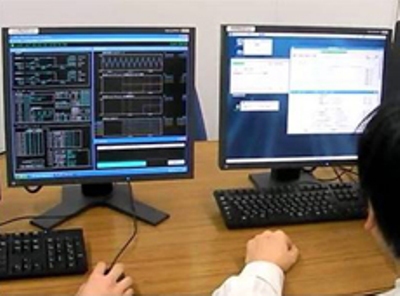 |
Demonstration using two desktop computers. The left screen monitors the state of the rocket, and the right screen carries out checks.
Courtesy of JAXA |
| |
The rocket launch control and autonomous-check systems, which use two desktop computers, have been verified with the actual hardware.
We are using a desktop at the moment, but eventually we’d like to be able to use a laptop.
As for the motor case, which no longer requires an autoclave for manufacturing, we have built a small carbon fiber prototype and are testing it now.
We have been able to confirm that it is possible to make a lighter and stronger motor case, so we plan to make a full-size model to test in the next two years.
Q. What do you think is the key development agenda?
Because the autonomous-check and mobile launch control system are new elements, they are probably people’s biggest concerns, and we understand that with these we can least afford to fail.
Needless to say, using artificial intelligence in the rocket is something that is only possible based on achievements made to this point.
However, these achievements are in people’s heads and not written in manuals.
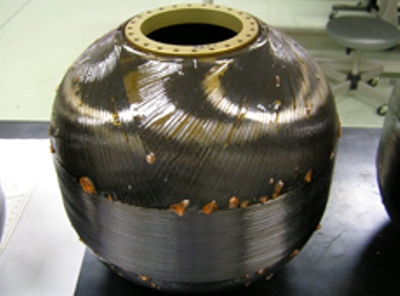 |
Prototype of a motor case made with a manufacturing method that does not require an autoclave.
Courtesy of JAXA |
| |
People have put what they have in their heads on the line for real-life performance.
But now, it is important to sort it out systematically and compile a database.
That is, I think that a key to this development is to sort out and systematize the foundation of what we have achieved to date, and make the knowledge usable.
It may be an overstatement to say that we are over the hump, but we have been able to verify the possibility of mobile launch control using a prototype model.
So I think that we are coming close to the stage where we can build a reliable launch vehicle and finish production in time for launch in 2013.
Q. What has been the reaction of people around you towards the Epsilon launch vehicle?
At first, when we talked about the Epsilon launch vehicle at conferences and so on, the majority of responses were that such a mobile launch control system would be impossible. However, last year, the project was covered in the U.S. magazine Aviation Week & Space Technology.
And since the publication of photos of the test we ran using two desktop computers to control the launch process, I have the impression that those who had hadn’t taken our project seriously are changing their mind.
However, the confidence of my colleagues who are working on the project is much more important to me than other people’s worrying.
I have a strong sense that the bond between us has grown tighter since development started three years ago.
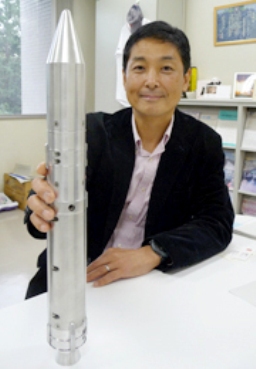 |
Professor Morita with a miniature of the Epsilon launch vehicle.
Courtesy of JAXA |
| |
Back then, some of us were still feeling uncertain about whether one or two computers would do, but today everyone is working with faith and confidence.
I think all the developers have a very strong determination to succeed with the Epsilon launch vehicle.
If our mobile launch control system works, it will be the most advanced technology in the field by far.
So in that sense I think this is a big opportunity.
Using Our Rocked to Open Up the Future
Q. What is the real pleasure of developing a new launch vehicle?
To me, it’s that we have an opportunity to open up the future.
If the Epsilon rocket enables much simpler and easier launches, the technology will surely be applied to the H-IIA launch vehicle, and will also be a good model for other international rockets.
Our mission is to bring about an incredible new world of rockets equipped with artificial intelligence, and I am very proud of my work.
It’s a great opportunity to create something completely new, and to establish world-class technology.
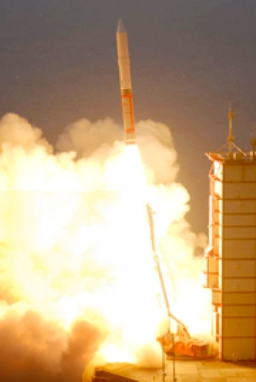 |
Final launch of the M-V launch vehicle on September 23, 2006.
Courtesy of JAXA |
| |
In 2006, further development of the M-V rocket was called off, and I kind of "graduated" from solid-fuel rockets.
At that time some people said, "Whatever can be done with solid-fuel rockets is done, so further development is no longer necessary."
But that’s when the Epsilon project kind of picked up.
When I thought about the significance of solid rockets, I realized that there was still so much potential.
So I began to persuade people around me to get the project launched.
In a sense this is a fresh beginning, having returned to the original starting point.
My feeling about the Epsilon launch vehicle is not just that we are picking up the torch from our predecessors, but that we are also, in another sense, building the next stage on our own, from scratch.
This gives us a strong sense that it is our rocket.
There is nothing more fortunate than being able to build our own rocket making full use of all the efforts made by our predecessors.
Q. You were also the project manager of the M-V rocket. What got you involved in the development of solid-fuel rockets? And were you always interested in space or rockets as a child?
I was more attracted to the world-class Japanese rockets than to solid-fuel rockets.
I found a position in rocket development because I had admired the forerunner of the M-V rocket, the M-3SII.
That rocket carried Japan’s first interplanetary spacecraft, the Halley's comet mission Sakigake and Suisei, in 1985, and I watched it when I was a graduate student.
It was the first time ever for a solid-fuel rocket, which was known for its difficult orbit control, to launch an interplanetary spacecraft, and I developed a strong interest in this world-class technology.
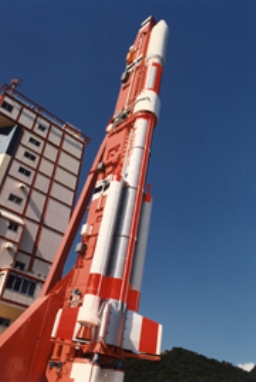 |
M-3SII rocket.
Courtesy of JAXA |
| |
When I was a child, it was the heyday of science fiction, and I used to love watching TV shows with robots that had artificial intelligence, such as Astro Boy, and rockets, like in Thunderbird, which took off simply at the press of a button.
It seems to me that rockets that can be ready for launch in a week and have artificial intelligence applications are very natural and normal things.
It is perhaps the influence of the sci-fi shows I watched as a child.
Rockets that are easy to launch were nothing special in the world of science fiction, so what I saw back then may be the prototype of the Epsilon launch vehicle.
Desire to Start a Revolution In the World of Rockets
Q. What do you think is ahead for the Epsilon launch vehicle?
In the first stage of development, a desktop computer will replace the enormous launch-control room.
This is the first step in our efforts to simplify the rocket-launch system.
In the second stage, around 2017, we hope to have the launch vehicle monitor and judge its own flight safety autonomously, so that we can remove the radar and antenna used to track and send commands to the rocket.
The role of the tracking radar and antenna on the ground are to track the rocket's orbit, and in case of an abnormality, send a destruct signal in order to prevent harm to people on the ground.
A tracking antenna for this purpose is up to 10 meters in diameter.
It works well, but it is also very expensive to build and maintain.
Therefore, we plan to further improve the artificial intelligence of the rocket so it can take care of its own fight safety - it will autonomously determine its orbit and condition, and self-destruct when it recognizes something unusual.
If we can achieve this, there will be no need to use expensive tracking radar, and we’ll be able to further simplify ground facilities.
After that, I would love to build a system for weekly rocket launches - say, a Mars exploration spacecraft this week and a space telescope next, for example.
If the number of rocket-launch opportunities could be increased like this, it would be a drastic change from today’s environment, where launch opportunities come only once every ten years.
By reducing the cost and increasing the frequency of launches, we can create a new environment to encourage and facilitate new challenges.
I also think it is important to use commercial, off-the-shelf components for rockets.
In rocket technology, out-of-date systems are still commonly used because they are known to be reliable.
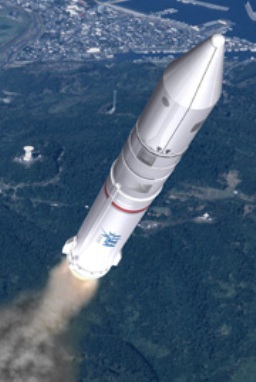 |
Epsilon launch vehicle in flight (artist’s rendition).
Courtesy of JAXA |
| |
In other words, rockets are made with a mishmash of very reliable but old-fashioned parts - like the ones used for a cathode ray tube TV, for example.
If there is light, cheap and sophisticated commercial off-the-shelf technology, it can help us reduce costs significantly.
This could start a revolution in the world of rockets.
Q. What are your future goals and dreams?
My goal for the near future is to bring the ambitious vision of the Epsilon launch vehicle to fruition.
What was thought to be impossible a few years ago is finally becoming reality.
We would like to finish building the first Epsilon launch vehicle, and then launch it successfully in 2013.
Beyond that, my goal is, again, to build a system that enables frequent rocket launches.
I don’t think that people imagined 30 years ago that airplanes would be flying as frequently as they are today.
It is my dream to make rockets that can take off as easily as airplanes.
Dr. Yasuhiro Morita, Ph.D.
Professor, Department of Space Systems and Astronautics, Institute of Space and Astronautical Science/JAXA
 |
Dr. Yasuhiro Morita, Ph.D.
Courtesy of JAXA |
| |
Dr. Morita earned his bachelor’s degree from the Department of Aeronautics, and his doctorate in aeronautics from the School of Engineering, at the University of Tokyo.
After working as a Visiting Research Fellow at the Department of Mechanical Engineering of the University of British Columbia in Canada, he became a Research Associate in the Department of Systems Engineering at ISAS in 1990 - the year when development of the M-V rocket began.
In addition to R&D for systems analysis and attitude control systems for M-V rocket, he was involved in a broad range of studies, including deployable structures for projects such as Mars explorer, and attitude control for small lunar modules.
He obtained the full professorship in 2003 in the Department of Space Transportation Engineering at ISAS.
He was also appointed project manager of the M-V rocket program in 2003, and has led the Epsilon rocket project since 2007.
Among his specialties are rocket attitude control and flexible space structure control.
SOURCE: JAXA
http://www.jaxa.jp/article/interview/index_e.html
http://www.jaxa.jp/article/interview/vol58/index_e.html
ASTROMAN Magazine - 2010.07.01
NEC Satellite Systems. HAYABUSA's seven-year journey in space
http://www.astroman.com.pl/index.php?mod=magazine&a=read&id=753
ASTROMAN Magazine - 2010.01.24
Rover Gives NASA an "Opportunity" to View Interior of Mars
http://www.astroman.com.pl/index.php?mod=magazine&a=read&id=650
ASTROMAN Magazine - 2010.01.10
Polskie satelity zbadają w kosmosie najgorętsze gwiazdy
http://www.astroman.com.pl/index.php?mod=magazine&a=read&id=637
ASTROMAN Magazine - 2009.07.11
Instytut Problemów Jądrowych dołączył do japońskiego programu badań kosmicznych
http://www.astroman.com.pl/index.php?mod=magazine&a=read&id=538








